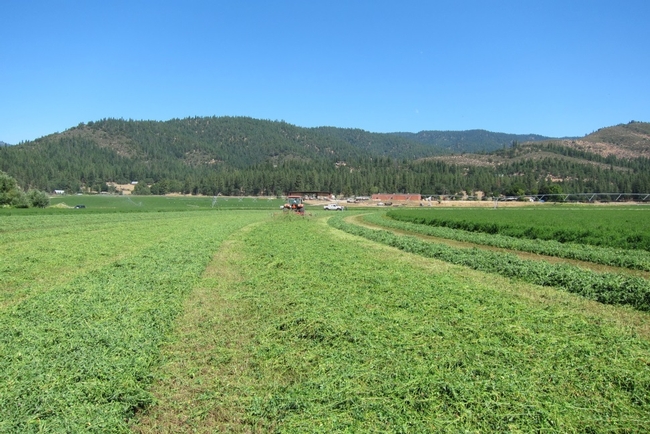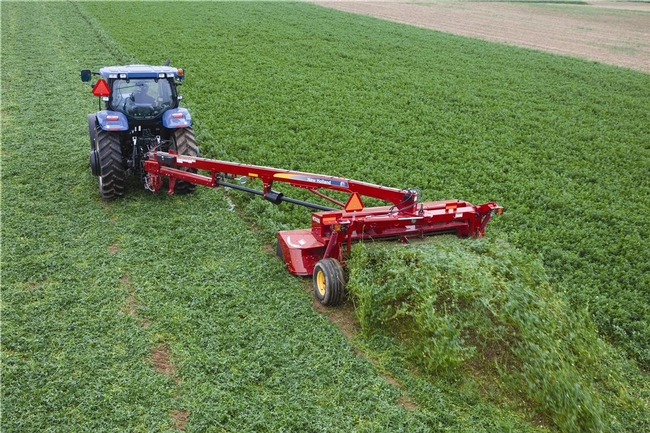- Author: Steve Orloff

Growers throughout the Western US are blessed with relatively good hay curing conditions most of the time. The arid, warm weather that occurs during the majority of the hay-making season is truly a blessing compared with the often rainy conditions growers in other parts of the country confront. Other alfalfa production regions, such as the Midwest, generally have much higher relative humidity and summer rains are commonplace. Perhaps for this reason, many California growers are not giving the attention to the hay curing process that this production phase deserves.
Why should California growers care about hay curing time? As long as the hay is put up without rain damage - isn’t that all that matters?
Actually NO… there are several advantages other than avoiding rain damage to “putting up hay” faster. First, alfalfa continues to respire (converting oxygen and sugars to carbon dioxide and water) until the moisture content of the forage drops to around 40 percent. Therefore, the more rapidly the moisture content of the alfalfa is reduced, the less soluble carbohydrates and sugars are lost. This results in higher sugars and soluble carbohydrates, and higher forage quality (TDN).
Curing Time Impacts Irrigation Efficiency. Fields obviously cannot be irrigated while the hay is curing. So the quicker the hay can be cured and removed from the field, the sooner irrigation can resume. The time when alfalfa is most susceptible to moisture stress is when the plant is regrowing after a cutting. It is surprising how long the water is “off” on fields to dry a field down prior to cutting until the bales are removed and the field re-watered. I have measured how long the water is “off” on some fields and it is commonly over 20 days and was even over 40 days without water on a couple of fields. Also, alfalfa regrowth under the windrow is delayed from a lack of sunlight, causing yellowing and delayed growth. The faster the hay is removed, the quicker regrowing alfalfa plants can be exposed to full sunlight. Lastly, running harvesting equipment over the regrowing alfalfa plants causes considerable damage. The faster the hay-making process, the less alfalfa regrowth is trampled. In a Davis trial, wheel traffic 6-7 days after harvests resulted in at least 25% yield reductions, due to crushing of the regrowth.
To understand how to expedite the hay curing process, it is useful to understand what actually is occurring when alfalfa is drying from cutting until it can be safely baled and stored.
The moisture content when alfalfa is cut is typically 85 to 75% and the forage must dry down to less than 14 to 20% moisture depending on bale size and environmental conditions. The drying rate of alfalfa depends on environmental conditions including solar radiation, temperature, relative humidity, wind velocity, and soil moisture. Research has shown that solar radiation is the most important of these factors.
There are two phases to the drying process. The first phase accounts for 75% of the moisture loss and occurs in only 20% of the total drying time. During this phase, moisture loss occurs through the pores or stomates on the leaves and through the cut ends and abrasions on the stem. The second phase commences at about 40% moisture and is far slower (1/100 of the original drying rate). Leaves dry much faster than stems, and that is part of the challenge with hay drying.
What influences drying time? Solar radiation and exposure to wind and warm temperatures are the primary factors affecting hay drying rate. So, what can we do to hasten drying? While conditioning is important, the configuration of the windrow (width and density) is the most important factor under the producer’s control that affects alfalfa drying rate. Some producers mistakenly believe that narrow windrows dry faster because they have less contact with the soil, and wind can blow through them because they are taller. However, research from across the US has repeatedly shown that wide windrows or swaths dry quicker, primarily because they intercept more solar radiation, the primary factor affecting drying rate. Rapid initial drying in a wide swath helps reduce respiration losses, which in turn reduces the loss of sugars and carbohydrates preserving total digestible nutrients and (TDN) and enhancing digestibility.
In the past, tall narrow windrows (3 to 3.5 ft. wide) were common in the Western US. A tall windrow was a good way to impress the neighbors. However, now with equipment advances and a better understanding of the factors that affect drying rates, growers have gradually adopted wider windrows. Conditioning rollers are around 9 feet in length on the newer swathers and windrow width can be easily altered with the simple adjustment of a lever.
While more growers have adopted wider windrows, some growers have yet to spread out their windrows. In general, Western alfalfa producers have not taken full advantage of research and grower experience in the Midwest that demonstrates the advantage of using still wider swaths to accelerate curing. I have heard that Midwestern growers can often make hay in 2-3 days in the summer, a feat that is rarely accomplished in the West.
Importance of wide windrows. Research has demonstrated the advantages of wide swaths. Shinners and Herzmann in 2006 compared the drying time of conditioned and unconditioned alfalfa placed in three swath widths: 25–35, 45–60, and 80–100% of the cut width. Conditioned alfalfa placed in a wide swath dried significantly faster than all the other treatments. A wide (about 70% of cut width) windrow reduces drying time by about 25 to 40% compared to a narrow windrow (about 45% of cut width).
Obtaining a swath that is 70% of the cut width is not easy to achieve with the self-propelled swathers we use in the West. It is much easier with the pull-type swathers used in the Midwest, especially when “wide thin fins” are used to further spread the windrow. Google “wide thin fins” if you want to see what is being done in other parts of the country. With self-propelled swathers, the width of the swath is limited by the distance between the front wheels of the swather.
Growers are also concerned about the potential for bleaching with wider swaths. However, the alfalfa can be raked sooner with wide swaths so the alfalfa may spend less time exposed to bleaching elements. In addition, UC Alfalfa Specialist Dan Putnam, found no difference in forage quality (ADF, NDF, CP, RFV or TDN) when sun bleached hay from the same windrows was compared with hay deeper in the windrow that was not sun-bleached. Sun-bleaching is more cosmetic than any actual change in forage quality. Timing of raking and the moisture content of the hay is an important consideration with any windrow width because more leaf loss occurs when raking dry hay than during the baling operation.
Let’s be Innovative. Innovations in harvest technique are an important strategy to improve both yield and quality of alfalfa. I am not an equipment guru and welcome reader comments and ideas on what can be done using new equipment, or the equipment we currently use in the West, to hasten curing through wider swaths or other practices. From my perspective as a UC agronomist, I don’t think we are taking fully advantage of production practices that can hasten the curing process. If you are not currently using the widest windrow your swather allows, you might want to give it a try. I believe the advantages of wide swaths are greatest in the spring and summer when days are longer, but that is just an opinion. This blog is intended not to just be a one-way flow of information. Your thoughts on this topic are welcome. Why can growers in the Midwest put up hay faster than we do in the West during the summer months and what can we to improve the process?





The idea is to cure the hay down dry enough to stop respiration by nightfall. Losses to respiration cannot visually be determined, only plot work will answer that.
With a 2 ton cutting of alfalfa to cure down to 20% moisture requires an accumulated pan evaporation of 0.49" with a 100% width swath, but 1.91" of pan evaporation for a 2 ft wide (10% of the ground covered with hay) windrow.
With a half inch/day pan evaporation the hay is ready to bale the first night while the windrow is ready to bale after 5 days. Figure 0.25" day one, 0.50" days two, three and four, the hay will be dry enough to bale sometime on day 6. Some time when there is enough humidity to bale the hay.
Here Dan Undersander and I are in agreement.
But WV's http://www.wvu.edu/~agexten/pubnwsltr/TRIM/5811.pdf is telling us that we need 90% relative humidity, down next to the hay, to rake hay, if the 40% hay moisture is a good idea for raking hay.
As I understand the problem, 70% humidity is not a sure thing for much of the Arid West. Not even down next to the swath or windrow. With a 70% RH the hay moisture can be in the 17% to 20% moisture range. Supposedly at 20% moisture for raking we can expect a 12% DM loss and a 20% leaf loss.
The question is will there be a greater Dry Matter & Quality loss with more than one day of respiration or from leaf shatter from raking hay that is not tough enough to rake.
Here in Central Texas I can expect the hay essentially dead by sunset if I finish mowing by our 3 PM. No overnight respiration!
I can rake that hay at first light with a good dew with minimal leaf loss.
Bale the third day as the humidity is going down to 70% humidity, at the windrow.
I have always assumed that the Arid Western States did not NEED the wide windrow because the <20% RH and gentle 20 knot breeze made it unnecessary.
Relative Humidity
The devil is in the details and there are a number of details.
http://www.wvu.edu/~agexten/pubnwsltr/TRIM/5811.pdf
http://pubs.ext.vt.edu/442/442-454/442-454.html
http://www.uwex.edu/ces/forage/pubs/drying_forage.pdf
This one has a number of pictures and charts and is slower to down load.
Interesting to me is the quality cost of the narrow windrow.
http://learningstore.uwex.edu/Assets/pdfs/A3927.pdf
This one is very simular to the one above, but has fewer pictures and downloads quickly. It was presentated at one of the outstanding December California Alfalfa Seminars. I heard this presentation. It required several readings and some careful study to appreciate the wisdom of this presentation.
http://alfalfa.ucdavis.edu/">http://alfalfa.ucdavis.edu/+symposium/proceedings/2008/08-235.pdf
Slightly dated but still valid information.
http://www.uwex.edu/ces/forage/wfc/proceedings2003/speedhaydrying.htm
Consider http://ucanr.edu/sites/Alfalfa/ 2013 December conference at Reno.
Look at the proceedings from 2012. http://alfalfa.ucdavis.edu/+symposium/2012/
Notice there are both the written presentation as well as a video & audio presentation on most topics.
The nice thing about Reno is Southwest Airlines.